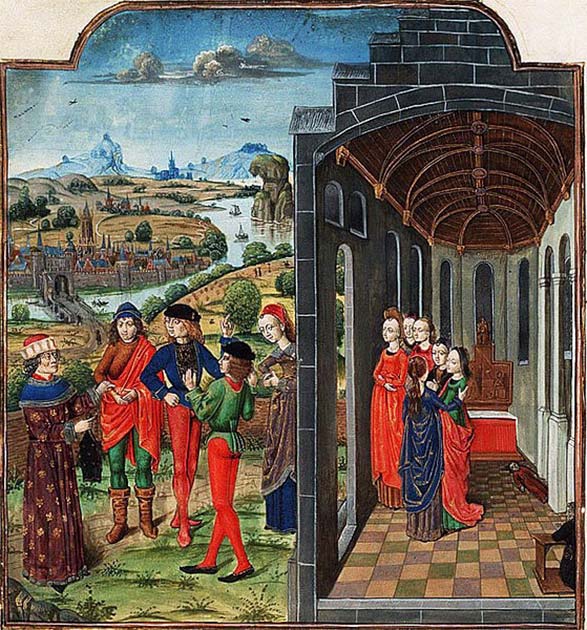The Silk Road was a true wonder of the world, a network of both land and sea that connected the Far East and China with Western Europe for 1,500 years. It was utilized from as early as 130 BC and was still operating at the fall of Constantinople in 1453 AD.
Throughout its long history, it was a vital source of leather goods, fabrics, spices, and precious stones. It allowed communities to connect and share their own innovations. Ideas and techniques like paper and printing, gunpowder, as well as language and culture were exchanged on this route.
However, this medieval highway also has a much darker and more lethal legacy. It enabled one of the largest and first pandemics to spread across the world. Of course, this was the plague known as the Black Death.
It struck between the years 1346 and 1352, killing more than 50 million people spread along its route from the length of Europe across the length of Asia. The Silk Road has been claimed by historians that it allowed, perhaps for the first time, a sustained transmission of disease from Central Asia into Europe.
A Hub of Infection
One reason why this trade network was so effective at spreading disease through microbes was that the Silk Road was more than just one single route. The overland part of the Silk Road was a set of paths split across the steppes of Central Asia. If you need to imagine it, you could think about the way the blood travels around the human body through a network of veins all crossing various parts.
Along the Silk Road, there were various villages, outposts, and towns named caravanserais which were set approximately one day’s hike apart. Very few travelers ever covered every aspect of the Silk Road.
It stretched for thousands of miles from Turkey to East Asia. Caravans of traders and camels traversed back and forth between their local spots trading wares and goods for gold and money before returning home.
- Marco Polo: From Venetian Merchant To Mongol Courtier, Or So He Claims
- Sweating Sickness of Tudor England
The traders and their animals would collect contagions along their route and spread them to the people that they traded with and to their families and their local villages. It would not have been a fast spread, but it gradually would have traveled from person to person and animal to animal.

It has been suspected that through sheer bad luck that the route of the Silk Road itself actually brought traders close to a potential source for the disease which increased the chances of spreading. Its very strength became a vector for disease.
A study conducted in 2015 by Scandinavian scientists has suggested that the climate changes in the 14th century may have caused the rat population in the Central Asian steppes to crash. They suspected that the particular suffers may have been gerbils and marmots.
With the rodent population crashing, their theory claims that the bacterium Yersinia Pestis, which caused the plague, fled from their hosts and find a new place to live such as trading animals and people. Several years of flea relocation led to a decade of the disease spreading to the caravans before taking it westward to Europe.
Scientists, archaeologists, and historians have suspected that Kaffa, a seaport on the Crimean Black Sea now known as Feodosia, was the starting point for the primary wave of the medieval Black Death in 1346-1347. The Genoese and Venetian traders used the port at Kaffa and traveled from there to places like Constantinople and Athens on their way back to Venice, Genoa, and Sicily.
However, this was not the only route. It would likely have also traveled via an overland route. Though a semi-contemporary report in the 14th century claimed that the plague was introduced to Kaffa deliberately by the Mongols as a biological warfare attack.
It is likely derived from the Mongol tactic of throwing plague-infected corpses over the city walls after they had sacked a city which certainly will have helped to spread the Black Death. Disease was an effective way to defeat cities when more straightforward attacks failed.
From East to West and Back Again
The plague became a disaster in both the East and the West. Many Mongol rulers and other elites from other cultures suffered as did their armies. Not only did it affect people though, but it also affected the economy, and led to many more deaths as local populations starved.
- Silk: China’s Secret Material, and how that Secret Got Out
- Plague Doctor: The Origin of the Venice Carnival Mask
In Asia and North Africa, it is estimated that around 25 million people were killed during the Black Death. A 2019 study by German researchers has shown that an outbreak from 1346 in Laishevo in the Volga region likely helped to spread the disease through Asia across a variety of routes.
The Black Death then arrived in Europe and ravaged much of the population. This was aided by the fact that the population was weak and malnourished due to the oppression and violence of the feudal economy.
The population of Europe was decimated by poverty, serfdom, wars, and famines. One report from Europe from Florence by Giovanni Boccaccio in 1348, described the Black Death as creating swellings in the groins and armpits before black spots on their arms and thighs started to appear.

He also revealed that between March and July, the inhabitants of Florence died in droves. Boccaccio claimed that it was 100,000 people and that their bodies were piled high outside the doorways of hovels and stately homes alike.
Unlike the modern world dealing with the pandemic of 2020, medieval European and Asian populations had to rely on a system of trial, error, and faith to help them survive. They implemented systems of quarantine, plague hospitals, and even masks were worn by doctors to protect them.
Border controls were put in place and borders were shut. Some communities even created health spies to warn countries and nations of impending plague waves. Much of the plague faded by the mid-1350s and populations began to grow again.
However, the Black Death never went away, the populations merely became resistant to it. The disease was not to be denied though and a different strain ravaged Europe in the 1700s and it made its way to the East in the 1800s.
The Black Death was able to spread thanks to a more connected and integrated world because of the Silk Road. Its many routes allowed the microbes to spread across people and animals.
Top Image: The Black Death, originating in China, was spread across the length of Asia and then Europe by the Silk Road. Source: Unknown Author / Public Domain.
By Kurt Readman